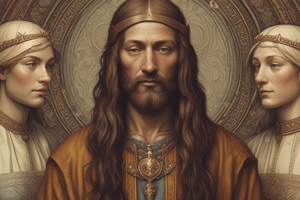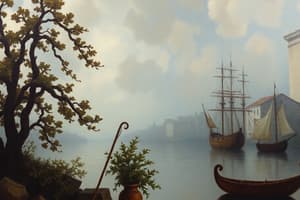Podcast
Questions and Answers
What does 'Renaissance' mean in French?
What does 'Renaissance' mean in French?
rebirth
What does classical mean?
What does classical mean?
Classical refers to the cultures of ancient Greek and Rome.
What did humanists believe in?
What did humanists believe in?
the worth and potential of all individuals
When and where did the Renaissance begin? When did it spread?
When and where did the Renaissance begin? When did it spread?
The Renaissance began with...
The Renaissance began with...
How did the Roman Catholic Church help keep knowledge of ancient times alive?
How did the Roman Catholic Church help keep knowledge of ancient times alive?
The classical period lasted from about _____ to _____.
The classical period lasted from about _____ to _____.
What was the purpose of much of the art created by the classical artists of Greece and Rome?
What was the purpose of much of the art created by the classical artists of Greece and Rome?
What did the classical artists value?
What did the classical artists value?
The medieval period lasted from about ______ to ______.
The medieval period lasted from about ______ to ______.
What was the purpose of much medieval art?
What was the purpose of much medieval art?
Most of the classical art was religious, showing Jesus, saints, people from the Bible, and so on.
Most of the classical art was religious, showing Jesus, saints, people from the Bible, and so on.
Most of the medieval art was religious, showing Jesus, saints, people from the Bible, and so on.
Most of the medieval art was religious, showing Jesus, saints, people from the Bible, and so on.
The Renaissance lasted from the ____s to the early ____s.
The Renaissance lasted from the ____s to the early ____s.
What was the aim of much Renaissance art?
What was the aim of much Renaissance art?
Were Renaissance artists inspired more by classical art or medieval art?
Were Renaissance artists inspired more by classical art or medieval art?
How were Renaissance artists similar to classical artists?
How were Renaissance artists similar to classical artists?
What does Renaissance art reflect?
What does Renaissance art reflect?
What factors contributed to the Renaissance?
What factors contributed to the Renaissance?
What did trade bring into Europe?
What did trade bring into Europe?
What did this bustling economy create?
What did this bustling economy create?
What was the economy like during the Middle Ages?
What was the economy like during the Middle Ages?
What was the economy like during the Renaissance?
What was the economy like during the Renaissance?
As a result of the new kind of economy during the Renaissance, what people became more important in society?
As a result of the new kind of economy during the Renaissance, what people became more important in society?
What is a patron?
What is a patron?
What is the definition of perspective?
What is the definition of perspective?
Due to the growth of trade and commerce, some merchants and bankers...
Due to the growth of trade and commerce, some merchants and bankers...
How did patrons help to grow prosperous Renaissance cities into flourishing educational and cultural centers?
How did patrons help to grow prosperous Renaissance cities into flourishing educational and cultural centers?
Flashcards are hidden until you start studying
Study Notes
Renaissance Overview
- "Renaissance" translates to "rebirth" in French, symbolizing a revival of interest in classical antiquity.
- The movement originated in Italy during the mid-1300s and expanded across Europe in the 1400s and 1500s.
- The Renaissance marked the rediscovery of ancient Greek and Roman cultures.
Classical vs. Medieval Art
- Classical refers to the cultural achievements and artistic output of ancient Greece and Rome.
- The classical period is defined as lasting from 500 B.C.E. to 500 C.E., with art focused on human importance, depicting people, leaders, and deities.
- In contrast, the medieval period spanned from 500 to 1300 C.E., with art primarily aimed at teaching religion to illiterate populations.
- Most classical art was not religious; however, medieval art predominantly depicted biblical subjects.
Renaissance Art Characteristics
- The Renaissance lasted from the 1300s to the early 1600s, emphasizing people and nature, moving away from exclusive religious themes.
- Artists were inspired more by classical art than medieval art, replicating its lifelike representations and everyday themes.
- Renaissance art reflects a renewed interest in classical ideals, employing perspective to enhance the appearance of depth in paintings.
Factors Contributing to the Renaissance
- The growth of trade and commerce led to prosperous cities and a wealthy class that supported education and the arts.
- Italian city-states played a crucial role in disseminating Renaissance ideas across Europe.
- The rise of humanism encouraged individuals to value personal worth and potential, fostering a new approach to thought and learning.
Economic Changes
- During the Middle Ages, economies were based on barter, whereas the Renaissance introduced a money economy with coins.
- The emergence of a money economy elevated the status of craftspeople, merchants, and bankers, essential for trade and finance.
- Wealthy merchants and patrons significantly impacted the growth of cities by financing artistic endeavors and the establishment of universities.
Role of Patrons
- Patrons, influential individuals who support the arts financially, were instrumental in fostering the cultural and educational development of Renaissance cities.
- Their investments led to the commissioning of new buildings and works of art, contributing to a flourishing atmosphere for education and creativity.
Studying That Suits You
Use AI to generate personalized quizzes and flashcards to suit your learning preferences.





